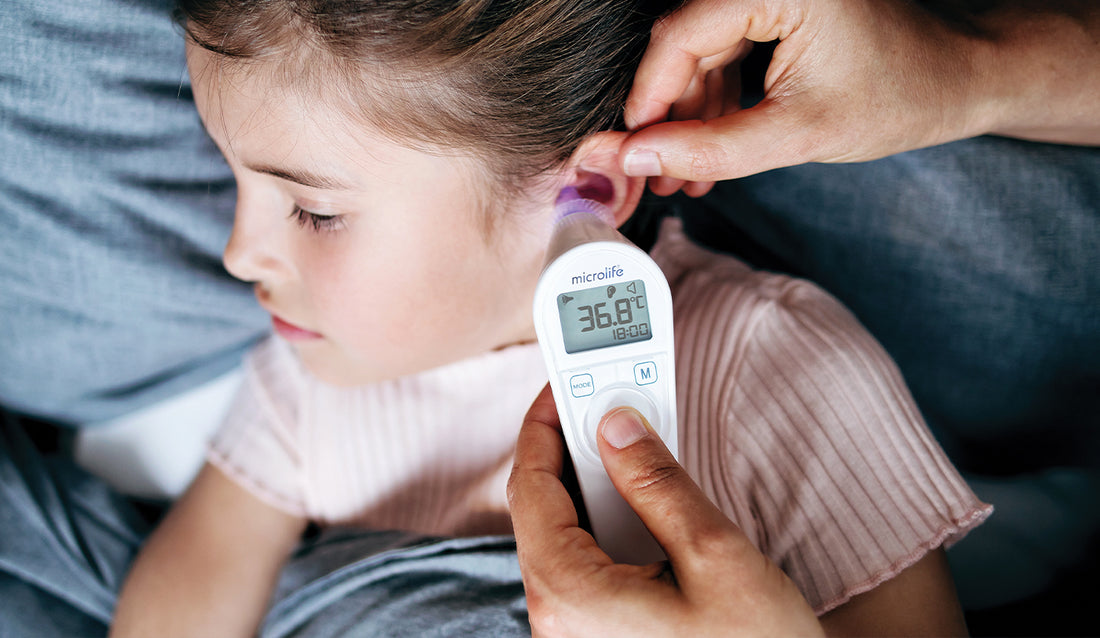First, choose the body part:
A. Rectal measurement
Taking a rectal measurement is the most reliable way to obtain a core temperature value. Result variation with this type of measurement is low and the precision is particularly high. The normal temperature range is approximately between 36.6 °C and 38.0 °C.
B. Oral measurement
An oral measurement can be taken as a buccal measurement (in the cheek) or as a sublingual measurement (under the tongue). In both cases, the temperature measured is below the measured value of a rectal measurement - approximately up to 1.1 °C. Whereby a sublingual measurement is preferable to a buccal measurement. The normal oral temperature range is approximately between 35.5 °C and 37.5 °C.
C. Axillary measurement
Measuring the body’s surface temperature is normally conducted by medical staff in the armpit (axillary measurement) and in the groin. The respective limb is pressed against the body to reduce the possible influence of the ambient temperature. However, this is only possible up to a certain body mass and this type of measurement also takes a long time.
In adult patients, the temperature of an axillary measurement is lower than a rectal measurement - up to 1.9 °C! The normal axillary temperature range is approximately between 34.7 °C and 37.3 °C.
Next, choose the right thermometer
There are different thermometers to choose from, depending on which body area you wish to take measurements from.

A. Ear thermometer
Here, the temperature of the eardrum is measured with an infrared sensor. The tip of the thermometer is simply inserted into the ear canal and the measurement result provided in just one second! In addition to the ease of use, this measurement method is also very reliable - provided the reliability has been proven for clinical purposes. Carefully constructed ear thermometers measure with a very high degree of accuracy and have low result variation. An optimally shaped thermometer tip is a prerequisite for precise measurements in infants and children.
The normal ear temperature range is approximately between 35.5 °C and 37.7 °C.

B. Forehead thermometer
These are perceived as the least disruptive and therefore the most comfortable way to measure body temperature. The forehead thermometer is placed on the forehead of the patient. An infrared sensor detects the highest measured value, while a second sensor measures the ambient temperature. The difference between these two measured values, taking into account clinical equalisation calculations, gives the body temperature which is shown on the LCD display.
The normal temperature range on the forehead is approximately between 35.4 °C and 37.4 °C.

Lastly, note the accuracy of the temperature measurement
It is important to differentiate between the technical accuracy with which the thermometer takes a reading and the clinical reliability of the specific measuring method. The accuracy of the thermometer is determined under ideal conditions in accordance with the relevant technical norms, in order to guarantee the measuring instrument’s quality. Modern high quality thermometers measure with an accuracy of +/-0.1 °C.
The technical precision and clinical reliability in the use of the thermometer should not be confused. Human body temperature varies depending on where on the body the temperature is taken and the time of measurement. This is due to physiological factors and must be distinguished from thermometer malfunction. Measurement accuracy primarily depends on whether the thermometer is used correctly (read the operating instructions!).
The following applies: The body temperature measured is always dependent on where the measurement is taken. Contrary to the widespread view, there is no “normal temperature”.
Looking for thermometers? Microlife thermometers are:
-
Mercury free: Mercury in thermometers has been officially forbidden by the European Union in April 2009 due to the fact that it is a highly toxic heavy metal. Microlife has always been producing mercury free thermometers due to its awareness of the human well-being and protection of the environment.
-
Biocompatibility: Microlife thermometers have been tested for biocompatibility in order to guarantee the absolute harmless application of the thermometers for the user. All the materials of applied parts in Microlife thermometers are biocompatible in compliance with ISO10993.
- Clinically tested in Europe: In cooperation with an Austrian hospital several studies have been conducted proving the accuracy and reliability of our infrared thermometers.
sources: microlife.com
If you like what you read, follow us on Facebook, Instagram, TikTok and Twitter to get the latest updates.

